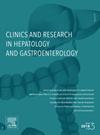The association between metabolic-associated fatty liver diseases and risk of colorectal polyps, neoplasia, and cancer: A systematic review and meta-analysis of over 56 million individuals
IF 2.4
4区 医学
Q2 GASTROENTEROLOGY & HEPATOLOGY
Clinics and research in hepatology and gastroenterology
Pub Date : 2025-07-22
DOI:10.1016/j.clinre.2025.102652
引用次数: 0
Abstract
Background and aims
Non-alcoholic fatty liver disease (NAFLD) and metabolic-associated fatty liver disease (MAFLD) affect over 30 % of the global population. Extrahepatic manifestations, including colorectal malignancies, represent the second leading cause of death in these patients. This study evaluates the association between NAFLD/MAFLD and colorectal polyps, neoplasia, and cancer.
Methods
A systematic search was conducted in PubMed, Web of Science, Scopus, and Google Scholar through June 2025. Observational studies reporting odds ratios (ORs) or hazard ratios for colorectal pathologies in NAFLD/MAFLD patients were included. Quality assessment was performed using Joanna Briggs Institute tools. Random-effects meta-analysis calculated pooled effect sizes with subgroup analyses to explore heterogeneity.
Results
Forty-eight studies encompassing 56,175,279 participants were analyzed. NAFLD/MAFLD was associated with significantly increased risk of colorectal polyps (OR 1.86, 95 % CI: 1.51–2.30), adenomas (OR 1.81, 95 % CI: 1.62–2.02), CRC (OR 1.37, 95 % CI: 1.30–1.45), overall neoplasia (OR 1.50, 95 % CI: 1.24–1.81), hyperplastic polyps (OR 1.60, 95 % CI: 1.34–1.91), and multiple adenomas (OR 1.49, 95 % CI: 1.16–1.91). Associations were confirmed in both imaging-based and biopsy-proven studies, with adjusted analyses supporting these findings. However, no significant association was found with advanced or large adenomas. Lean patients (BMI <25 kg/m²) showed stronger associations with adenoma risk than those with BMI ≥25 kg/m² (p = 0.027). Sensitivity analyses confirmed the robustness of the results.
Conclusion
NAFLD/MAFLD significantly increases colorectal polyp risk, particularly adenomas, hyperplastic polyps, overall neoplasia, and CRC, emphasizing the need for targeted colorectal screening. Future research should focus on prospective studies and mechanistic insights to enhance preventive strategies.
代谢相关脂肪性肝病与结直肠息肉、肿瘤和癌症风险之间的关系:一项超过5600万人的系统综述和荟萃分析
背景和目的:非酒精性脂肪性肝病(NAFLD)和代谢相关脂肪性肝病(MAFLD)影响全球30%以上的人口。肝外表现,包括结直肠恶性肿瘤,是这些患者死亡的第二大原因。本研究评估了NAFLD/MAFLD与结直肠息肉、肿瘤和癌症之间的关系。方法:系统检索PubMed、Web of Science、Scopus、谷歌Scholar等数据库至2025年6月。观察性研究报告了NAFLD/MAFLD患者结肠直肠病理的优势比(ORs)或风险比。使用Joanna Briggs Institute工具进行质量评估。随机效应荟萃分析通过亚组分析计算合并效应量以探索异质性。结果:48项研究共分析了56,175,279名参与者。NAFLD/MAFLD与结直肠息肉(OR 1.86, 95% CI: 1.51-2.30)、腺瘤(OR 1.81, 95% CI: 1.62-2.02)、结直肠癌(OR 1.37, 95% CI: 1.30-1.45)、整体瘤变(OR 1.50, 95% CI: 1.24-1.81)、增生性息肉(OR 1.60, 95% CI: 1.34-1.91)和多发性腺瘤(OR 1.49, 95% CI: 1.16-1.91)的风险显著增加相关。基于影像学和活检证实的研究证实了两者之间的联系,并进行了调整分析,支持这些发现。然而,在晚期或较大的腺瘤中没有发现明显的相关性。结论:NAFLD/MAFLD显著增加结直肠息肉的风险,尤其是腺瘤、增生性息肉、整体瘤变和结直肠癌,强调需要进行有针对性的结直肠筛查。未来的研究应侧重于前瞻性研究和机制见解,以加强预防策略。
本文章由计算机程序翻译,如有差异,请以英文原文为准。
求助全文
约1分钟内获得全文
求助全文
来源期刊

Clinics and research in hepatology and gastroenterology
GASTROENTEROLOGY & HEPATOLOGY-
CiteScore
4.30
自引率
3.70%
发文量
198
审稿时长
42 days
期刊介绍:
Clinics and Research in Hepatology and Gastroenterology publishes high-quality original research papers in the field of hepatology and gastroenterology. The editors put the accent on rapid communication of new research and clinical developments and so called "hot topic" issues. Following a clear Editorial line, besides original articles and case reports, each issue features editorials, commentaries and reviews. The journal encourages research and discussion between all those involved in the specialty on an international level. All articles are peer reviewed by international experts, the articles in press are online and indexed in the international databases (Current Contents, Pubmed, Scopus, Science Direct).
Clinics and Research in Hepatology and Gastroenterology is a subscription journal (with optional open access), which allows you to publish your research without any cost to you (unless you proactively chose the open access option). Your article will be available to all researchers around the globe whose institution has a subscription to the journal.
 求助内容:
求助内容: 应助结果提醒方式:
应助结果提醒方式:


